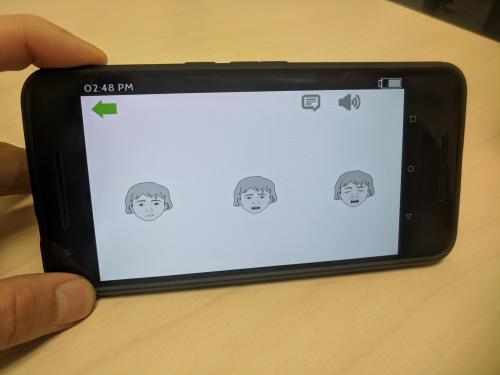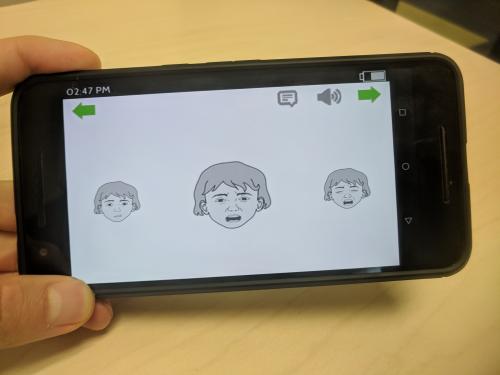The Simplified Faces Pain Scale (S-FPS) is designed for use with 3- to 5-year-old children and is based on a 2-step self-report method: children are first asked whether they have pain or hurt (yes/no); only if yes, then pain intensity is self-reported using a 3-point scale with faces designed to signify mild, moderate and severe pain intensity.
This page provides information about the S-FPS, including how to obtain the image file, the Creative Commons license, citation details, and detailed instructions for using the scale and translating it to other languages.
Click on the links below to go to a particular section for more information:
- Simplified Faces Pain Scale (S-FPS) image files
- Permission for use and reproduction of the S-FPS
- Citing the S-FPS
- Instructions for use of the S-FPS
- Research with the S-FPS
- Translation to other languages
- Contact
- References
- Acknowledgement
Simplified Faces Pain Scale (S-FPS) image files
High-resolution images are available here:
The monochrome/greyscale image may be printed, or used on an electronic device. For example, the S-FPS was implemented on a tablet device for its original evaluation (see Emmott et al. in the Journal of Pain May 2017) and has been included in the Panda smartphone application for postoperative pain management in children (described in Sun et al., 2018).
 |
 |
The size of the full S-FPS image, displayed in landscape mode, should be 10 cm minimum width (preferably larger).
Permission for use and reproduction of the S-FPS
The Simplified Faces Pain Scale is licensed under a Creative Commons Attribution-NoDerivatives 4.0 International License. This allows the use and sharing of S-FPS (without further permission needed) in any medium or format, provided that credit is given and this license is cited. No alterations may be published without permission. The minimum image caption is as follows:
Simplified Faces Pain Scale (S-FPS). Source: bcchr.ca/sfps
Licensed under CC BY-ND 4.0.
Citing the S-FPS
The primary S-FPS publication, which details the development and testing of the S-FPS is:
- Emmott AS, West N, Zhou G, Dunsmuir D, Montgomery CJ, Lauder GR, von Baeyer CL. Validity of Simplified Versus Standard Self-Report Measures of Pain Intensity in Preschool-Aged Children Undergoing Venipuncture. J Pain. 2017;18(5):564-573. [Abstract]
If you also wish to include the S-FPS image, please cite this web page (bcchr.ca/sfps) and license details as above.
Instructions for use of the S-FPS
The child is first asked whether he/she is in any pain, using terms familiar to the child and/or age- and context- appropriate (e.g., ‘‘hurt,’’ ‘‘ouch,’’ etc.).
- The answer “no” can be scored as 0 on a 0-10 scale and the accompanying faces scale is not used.
- Only if the answer is “yes”, the child is presented with the S-FPS and asked to rate the intensity of their pain using the following language (as above, a different term for ‘hurt’ may be substituted):
"These faces show how much something can hurt. This face [point to left-most face] shows a little bit of hurt. This face [point to middle face] shows a medium amount of hurt. And this face [point to right-most face] shows very much hurt. Touch the face that shows how much you hurt right now.’’
The three faces can be scored as 3, 7 and 10 on a 0-10 scale.
Research with the S-FPS
We encourage use of the S-FPS in any research studies. Consider the following when designing your study and reporting your results:
- Report results separately by year of age (see von Baeyer et al., 2017).
- If multiple self-report scales are used, report the order in which they were administered.
- Report the number and type of difficulties encountered by children in using the scale.
- If the wording of instructions is adapted or altered, specify how.
Translation to other languages
This should be based on the method of translation, back-translation, and verification (see references below):
- Translate. Start with the English version given above, which has been evaluated in a clinical setting. Translate the instructions into the new language.
- Read. Have the new version read by several people who are familiar with young children’s use of language (e.g., teachers, nurses). It should be suitable for children 3-5 years of age.
- Back-translate. Have the new version back-translated into English by a bilingual person who does not know anything about the S-FPS and has not seen the original version. Compare the original with the back-translation and make any needed adjustments in the translation.
- Pilot. Test the scale with several young children, noting any difficulties they have in understanding the instructions and again make any needed adjustments in the translation.
- Disseminate. Decide how you will distribute the S-FPS image and the new version of the instructions to users and how they will be trained to administer the scale.
Once you have an established version, you may:
- Collect data. It will be valuable to compare data using the S-FPS in different cultures and language groups. Gather data on pain scores from various groups, especially noting age, sex, and source of pain. As examples, Miró & Huguet (2004) and Newman et al. (2005) have done this with the Faces Pain Scale – Revised (FPS–R) in Spain and Thailand, respectively.
Contact
For further information, please contact:
The Digital Health Innovation Lab
| Address: |
BC Children’s Hospital Research Institute |
| Tel: | 1-604-875-2000 ext. 5318 |
| Email: | DHIlab@bcchr.ca |
References
Primary S-FPS publication:
- Emmott AS, West N, Zhou G, Dunsmuir D, Montgomery CJ, Lauder GR, von Baeyer CL. Validity of simplified versus standard self-report measures of pain intensity in preschool-aged children undergoing venipuncture. Journal of Pain. 2017;18(5):564-573. [Abstract]
The Simplified Concrete Ordinal Scale (S-COS) is also described in this article. The S-COS is free of copyright and no permission is required to use, alter, or reproduce it.
For more information about self-reported pain scales in 3- to 5-year-old children, see also:
- von Baeyer CL, Jaaniste T. Can preschool-age children reliably report the intensity of their pain? Invited blog post, www.bodyinmind.org/children-reporting-pain, 6 Oct 2017.
- von Baeyer CL, Jaaniste T, Vo HLT, Brunsdon G, Lao AH-C, Champion GD. Systematic review of self-report measures of pain intensity in 3- and 4-year-old children: Bridging a period of rapid cognitive development. Journal of Pain. 2017;18(9):1017-1026. [Abstract]
- Chan JY, von Baeyer CL. Cognitive developmental influences on the ability of preschool-age children to self-report their pain intensity. Pain. 2016;157(5);997-1001.
- von Baeyer CL, Chambers CT, Forsyth SJ, Eisen S, Parker JA. Developmental data supporting simplification of self-report measures of pain for preschool-age children. Journal of Pain. 2013;14(10):1116-1121. [Abstract]
- von Baeyer CL, Uman LS, Chambers CT, Gouthro A. Can we screen young children for their ability to provide accurate self-reports of pain? Pain. 2011;152(6):1327-1333. [Abstract]
- von Baeyer CL, Forsyth SJ, Stanford EA, Watson M, Chambers CT. Response biases in preschool children’s ratings of pain in hypothetical situations. European Journal of Pain, 2009;13:209-213. [Abstract]
- Besenski LJ, Forsyth SJ, von Baeyer CL. Screening young children for their ability to use self-report pain scales. Pediatric Pain Letter. 2007:9(4), 1-6. [Article]
Development and evaluation of the Panda application:
- Sun T, Dunsmuir D, Miao I, Devoy GM, West NC, Görges M, Lauder GR, Ansermino JM. In-hospital usability and feasibility evaluation of Panda, an app for the management of pain in children at home. Pediatric Anesthesia. 2018 Oct;28(10):897-905. [Abstract]
- Sun T, West N, Ansermino JM, Montgomery CJ, Myers D, Dunsmuir D, Lauder GR, von Baeyer CL. A smartphone version of the Faces Pain Scale-Revised and the Color Analog Scale for postoperative pain assessment in children. Pediatric Anesthesia. 2015;25(12):1264-1273. [Abstract]
Translating to other languages:
- Behling O & Law KS. Translating questionnaires and other research instruments. Sage University Papers. Quantitative Applications in the Social Sciences. London: Sage Publications, 2000, 07-133.
- Chang AM, Chau JP, Holroyd E. Translation of questionnaires and issues of equivalence. Journal of Advanced Nursing. 1999;29(2):316-22. [Abstract]
- Hilton A & Skrutkowski M. Translating instruments into other languages: development and testing processes. Cancer Nursing. 2002;25(1):1-7. [Abstract]
- Miró J & Huguet A. Evaluation of reliability, validity, and preference for a pediatric pain intensity scale: The Catalán version of the Faces Pain Scale – Revised. Pain, 2004;111(1-2):59-64. [Abstract]
- Newman CJ, Lolekha R, Limkittikul K, Luangxay K, Chotpitayasunondh T, Chanthavanich P. A comparison of pain scales in Thai children. Archives of Disease in Childhood. 2005;90(3):269-70. [Abstract]
Acknowledgement
The original artwork for the S-FPS was provided by UX/UI Designer, Patricia Bernal.
